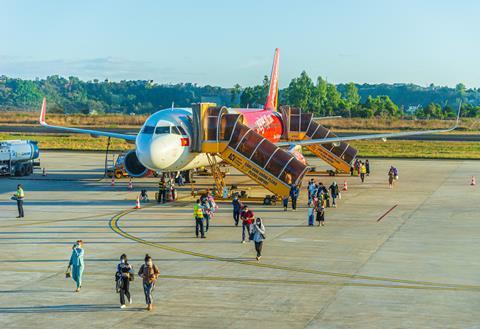Domestic air travel demand has “fully recovered” from the Covid-19 crisis, according to IATA, with overall global traffic now less than 10% down on 2019 levels as international markets catch up.
Commenting on the airline association’s latest traffic data, which covers April 2023, IATA director general Willie Walsh cites “sustained strong air travel demand”, which is being boosted by “the easing of inflation and rising consumer confidence”.
Walsh also highlights declining jet fuel prices as an indicator of “moderating cost pressures” at airlines.
Global domestic traffic during the month – measured in revenue passenger kilometres (RPKs) – was 2.9% up on April 2019, while international RPKs were at 83.6% of 2019 levels, IATA data shows. Both metrics were boosted by China’s relaxation of Covid-19 restrictions as 2023 began, improving connectivity in one of the world’s largest airline markets.
| Global air passenger market: April 2023 change versus April 2019 | |||||
|---|---|---|---|---|---|
| World share RPKs ’22 |
RPKs | ASKs | Load factor |
Load factor April ’23 |
|
| Africa | 2.1% | -16.2% | -12.5% | -3.1pp | 70.8% |
| Asia Pacific | 22.1% | -18.4% | -14.7% | -3.6pp | 78.4% |
| Europe | 30.7% | -7.8% | -6.2% | -1.4pp | 83.8% |
| Latin America | 6.4% | -1.5% | -0.6% | -0.7pp | 81.4% |
| Middle East | 9.8% | -12.1% | -7.0% | -4.4pp | 76.0% |
| North America | 28.9% | 2.1% | 1.2% | 0.8pp | 85.6% |
| Total market | -9.5% | -7.5% | -1.8pp | 81.3% | |
| Source: IATA Notes: Data is for airlines based in each respective region. pp=percentage points | |||||
Overall, the global industry’s traffic was 9.5% down on 2019 levels in April, on capacity – measured in available seat kilometres – some 7.5% lower. That continued an improving trend seen since December 2022, when RPKs were 23.1% down and capacity 22.1% lower, having trended in the -26% to -22% zone for much of the second half of last year.
Among the domestic markets, India’s traffic was some 14.7% higher than 2019 levels in April this year, IATA says, while China’s was up 6% and the USA’s 3.3%. Those increases were offset to some extent by Australia being 12.7% down on the same basis, Japan 4.4% lower and Brazil 2.4% down.
Notably, China’s domestic traffic had been down 55.5% as recently as December 2022.
Asia-Pacific continues to weigh on the recovery of international markets, with its airlines seeing traffic down 34.4% versus 2019 levels in April. Crucially, however, that is a significant improvement from their international traffic being down by almost 50% as recently as December 2022, as the reopening of China also feeds through to the international RPK data.

Of the other major markets, European airlines saw international traffic down 9.4% on 2019 levels in April, while RPKs from North American carriers were up 0.4%.
The global load factor of 81.3% in April was 1.8 percentage points down on the 2019 level.
Year-on-year traffic and capacity figures continue to benefit from the dampening effect of the industry’s emergence from the pandemic in the first half of 2022. Global traffic was up 64.4% year on year in April, on capacity 39.8% higher.
IATA’s latest figures for the cargo sector make for less positive reading.
Global demand measured in cargo tonne-kilometres was down 6.6% year on year in April, on capacity some 13.4% higher, amid a business environment that is ”challenging to read”, IATA says.
”The resilience that got the air cargo industry through the Covid-19 crisis is also critical in the aftermath,” says Walsh.


























